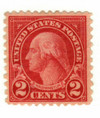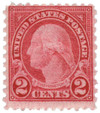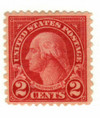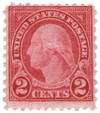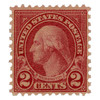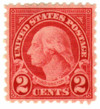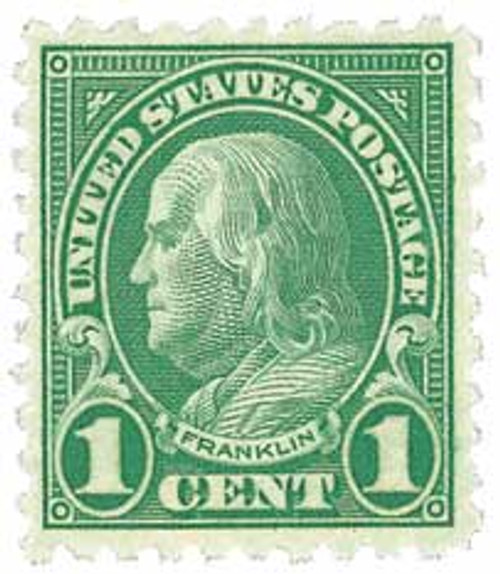
1923 2c Washington, carmine
# 579 - 1923 2c Washington, carmine
$28.00 - $1,150.00
U.S. #579
Series of 1923-25 2¢ George Washington
Coil Waste
Series of 1923-25 2¢ George Washington
Coil Waste
Issue Date: February 20, 1923
First City: Washington, D.C.
Quantity Issued: Unknown
Printed by: Bureau of Engraving and Printing
Printing Method: Rotary Press
Perforation: 11x10
Color: Carmine
First City: Washington, D.C.
Quantity Issued: Unknown
Printed by: Bureau of Engraving and Printing
Printing Method: Rotary Press
Perforation: 11x10
Color: Carmine
Unlike U.S. #578, which was only cut into 170-subject sheets, U.S. #579 was also cut into 100-subject and 70-subject panes. This made them easier to package and store, but was a departure from the Bureau’s normal practice of keeping record by plate number (on complete 170-subject sheets).
Series of 1922 Coil Waste Stamps
Due to poor centering and other minor defects, a number of coil stamp sheets had been set aside as “waste” to be destroyed. Some of them had been perforated vertically or horizontally, while others had not been perforated at all. According to Bureau Director James Wilmeth, they had been “laid aside as mutilated because they cannot be made into coils on account of some defect.” Although these stamps were unsuitable for coils, they could be issued satisfactorily as sheet stamps.
In an effort to save money, which was still in short supply after the war, the Bureau decided to release these stamps in sheets. Numerous sheets of the 1¢ Green, 2¢ Carmine Rose, and 3¢ Violet had already been perforated 10 vertically. They were then perforated 11 horizontally and issued with 11x10 perforations.
The practice began during the production of Series of 1919-21 stamps, and was continued in 1922. Yet in less than two years it ended. Some stamp historians argue that prominent stamp collectors had petitioned the Bureau to stop. Other factors also contributed. On January 1, 1923, the Treasury Secretary agreed to a lower rate for rotary press stamps. This made the time-consuming process of salvaging coil waste and turning it into usable sheets less attractive.
Rotary Press Production
In 1921, the Post Office Department established the Philatelic Agency, Division of Stamps, at the Washington, D.C., Post Office. This development was significant to the world of stamp collecting. To collectors, it indicated that the Postal Department took their efforts seriously and realized their growing importance. Catering to special philatelic requests and answering collectors’ questions had become a full-time job, and postal clerks had little time for their regular duties. By organizing such a division, it was hoped that both regular patrons’ and collectors’ requests would be handled accurately and promptly.
The primary function of the department was to fill orders for items such as well-centered stamps, plate blocks, and other special philatelic material. At the time the project was begun, many thought it would never amount to much and was a waste of money. That first year, sales totaled $20,906.00. However, by 1933 the numbers had jumped, and the total sales for the last six months of the year alone came to $333,476.62. Today, the profit from stamps sold to collectors totals almost $175 million.
With the creation of this agency, the Department also began to distribute advance information on new issues, lists of stamp in stock, and other news that was of interest to collectors. In addition, publication releases were prepared for use by the press and stamp journals.
U.S. #579
Series of 1923-25 2¢ George Washington
Coil Waste
Series of 1923-25 2¢ George Washington
Coil Waste
Issue Date: February 20, 1923
First City: Washington, D.C.
Quantity Issued: Unknown
Printed by: Bureau of Engraving and Printing
Printing Method: Rotary Press
Perforation: 11x10
Color: Carmine
First City: Washington, D.C.
Quantity Issued: Unknown
Printed by: Bureau of Engraving and Printing
Printing Method: Rotary Press
Perforation: 11x10
Color: Carmine
Unlike U.S. #578, which was only cut into 170-subject sheets, U.S. #579 was also cut into 100-subject and 70-subject panes. This made them easier to package and store, but was a departure from the Bureau’s normal practice of keeping record by plate number (on complete 170-subject sheets).
Series of 1922 Coil Waste Stamps
Due to poor centering and other minor defects, a number of coil stamp sheets had been set aside as “waste” to be destroyed. Some of them had been perforated vertically or horizontally, while others had not been perforated at all. According to Bureau Director James Wilmeth, they had been “laid aside as mutilated because they cannot be made into coils on account of some defect.” Although these stamps were unsuitable for coils, they could be issued satisfactorily as sheet stamps.
In an effort to save money, which was still in short supply after the war, the Bureau decided to release these stamps in sheets. Numerous sheets of the 1¢ Green, 2¢ Carmine Rose, and 3¢ Violet had already been perforated 10 vertically. They were then perforated 11 horizontally and issued with 11x10 perforations.
The practice began during the production of Series of 1919-21 stamps, and was continued in 1922. Yet in less than two years it ended. Some stamp historians argue that prominent stamp collectors had petitioned the Bureau to stop. Other factors also contributed. On January 1, 1923, the Treasury Secretary agreed to a lower rate for rotary press stamps. This made the time-consuming process of salvaging coil waste and turning it into usable sheets less attractive.
Rotary Press Production
In 1921, the Post Office Department established the Philatelic Agency, Division of Stamps, at the Washington, D.C., Post Office. This development was significant to the world of stamp collecting. To collectors, it indicated that the Postal Department took their efforts seriously and realized their growing importance. Catering to special philatelic requests and answering collectors’ questions had become a full-time job, and postal clerks had little time for their regular duties. By organizing such a division, it was hoped that both regular patrons’ and collectors’ requests would be handled accurately and promptly.
The primary function of the department was to fill orders for items such as well-centered stamps, plate blocks, and other special philatelic material. At the time the project was begun, many thought it would never amount to much and was a waste of money. That first year, sales totaled $20,906.00. However, by 1933 the numbers had jumped, and the total sales for the last six months of the year alone came to $333,476.62. Today, the profit from stamps sold to collectors totals almost $175 million.
With the creation of this agency, the Department also began to distribute advance information on new issues, lists of stamp in stock, and other news that was of interest to collectors. In addition, publication releases were prepared for use by the press and stamp journals.





